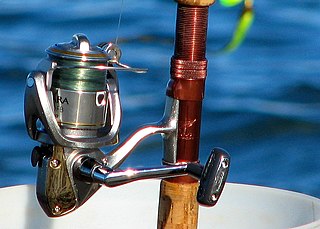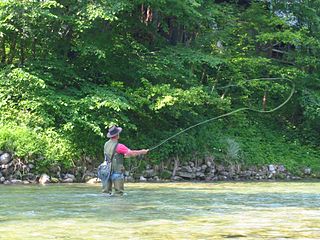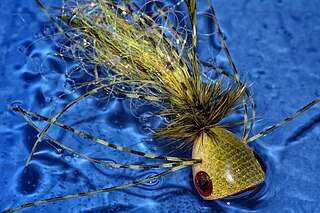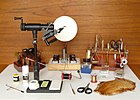
Trolling is a method of fishing where one or more fishing lines, baited with lures or bait fish, are drawn through the water. This may be behind a moving boat, or by slowly winding the line in when fishing from a static position, or even sweeping the line from side-to-side, e.g. when fishing from a jetty. Trolling is used to catch pelagic fish such as salmon, mackerel and kingfish.

A fishing rod is a long, elastic rod used by fishermen to catch fish by manipulating a line ending in a hook. At its simplest form, a fishing rod is a straight stick or pole with a line attached to one end, but modern rods generally have the line stored on a reel mounted at the rod handle, which controls the line retrieval, as well as line-guiding swivels that reduce tangling. To better entice fish, bait or lures are dressed on the one or more hooks attached to the line, and a bite indicator is used, some of which might be incorporated as part of the rod itself.

A fishing reel is a cranking reel attached to a fishing rod used in winding and stowing fishing line.

A fishing line is a cord used or made for angling. Fishing lines generally resemble a long, thin string, and vary in material. Important attributes of a fishing line include length, material, weight, and thickness. Other factors relevant to certain fishing environments include breaking strength, knot strength, UV resistance, castability, limpness, stretch, abrasion resistance, and visibility. Most modern lines are made from nylon, braided polymers, or silk.

Fly fishing is an angling method that uses a light-weight lure—called an artificial fly—to catch fish. The fly is cast using a fly rod, reel, and specialized weighted line. The light weight requires casting techniques significantly different from other forms of casting. The flies may resemble natural invertebrates, bait-fish, or other food organisms.

Angling is a method of fishing by means of a fish hook or "angle". The hook is attached to a fishing line, which is usually manipulated via a fishing rod, although rodless techniques such as handlining also exist. Modern fishing rods are usually fitted with a fishing reel that functions as a cranking device for storing, retrieving and releasing out the line, although Tenkara fishing and cane pole fishing are two rod-angling methods that do not use a reel. The hook itself can be additionally weighted with a tackle called a sinker, and is typically dressed with an appetizing bait to attract the fish, but sometimes an inedible fake bait known as a lure with multiple attached hooks is used in place of a single hook with bait. A bite indicator, such as a float or a quiver tip, is often used to relay underwater status of the hook to the surface.

Recreational fishing, also called sport fishing or game fishing, is fishing for leisure, exercise or competition. It can be contrasted with commercial fishing, which is professional fishing for profit; or subsistence fishing, which is fishing for survival and livelihood.

A fishing lure is a type of artificial fishing bait which is designed to attract the attention of predatory fish, using prey-like appearances, movements, vibrations, bright reflections and flashy colors to appeal to the fish's predation instinct and entice it into striking. Many lures are equipped with one or more hooks that anchor into the fish's mouth when it bites and swallows the lure. Some hookless lures are placed to bait the fish nearer so it can can be impaled with a spear or be captured by hand.

Fishing tackle is the equipment used by anglers when fishing. Almost any equipment or gear used for fishing can be called fishing tackle. Some examples are hooks, lines, sinkers, floats, rods, reels, baits, lures, spears, nets, gaffs, traps, waders and tackle boxes.

In the British Isles, coarse fishing refers to angling for rough fish, which are fish species traditionally considered undesirable as a food or game fish. Freshwater game fish are all salmonids — most particularly salmon, trout and char — so generally coarse fish are freshwater fish that are not salmonids. There is disagreement over whether grayling should be classified as a game fish or a coarse fish.
Dry fly fishing is an angling technique in which the lure is an artificial fly which floats on the surface of the water and does not sink below it. Developed originally for trout fly fishing, it is sometimes regarded as the supreme fishing sport, owing to its difficulty in both manual dexterity and understanding of the fish in its environment.

The Pheasant Tail nymph or PT Nymph or Sawyer’s Pheasant Tail is a popular all purpose nymph imitation used by fly anglers. It imitates a large variety of olive, olive-brown colored aquatic insect larvae that many fish including trout and grayling feed upon.
Spin fishing is an angling technique where a spinning lure is used to entice the fish to bite. Spin fishing is used in both freshwater and marine environments. Spin fishing is distinguished between fly fishing and bait cast fishing by the type of rod and reel used. There are two types of reels used when spin fishing, the open faced reel and the closed faced reel. The spin fishing rod has no trigger attached to the base of the fishing rod. This is what differentiates the spin fishing rod from the bait casting fishing rod.

Fishing techniques are methods for catching fish. The term may also be applied to methods for catching other aquatic animals such as molluscs and edible marine invertebrates.

The popper is an effective and proven lure designed to move water using a concave or hollowed nose. Poppers aim to simulate any sort of distressed creature that might be moving or struggling on the surface of the water. Poppers are used with spin fishing and fly fishing.
Fly fishing tackle comprises the fishing tackle or equipment typically used by fly anglers. Fly fishing tackle includes:
The following outline is provided as an overview of and topical guide to fishing:

Tenkara fishing is a type of simple rod angling traditionally practiced in Japan. Primarily used for mountain stream trout fishing, tenkara is still a fairly rare method even among freshwater anglers in Japan, and was largely unknown outside Japan until 2009, when the company Tenkara USA, founded by Daniel Galhardo, introduced and popularized tenkara outside Japan.
Spey casting is a casting technique used in fly fishing. Spey casting can be accomplished with either a normal length fly rod, or a rod referred to as a double-handed fly rod, often called a Spey rod. Spey rods can also be used for standard overhead casting.
Invertebrate drift is the downstream transport of invertebrate organisms in lotic freshwater systems such as rivers and streams. The term lotic comes from the Latin word lotus, meaning washing, and is used to describe moving freshwater systems. This is in contrast with lentic coming from the Latin word lentus, meaning slow or motionless that typically describe still or standing waters such as lakes, ponds, and swamps.


















